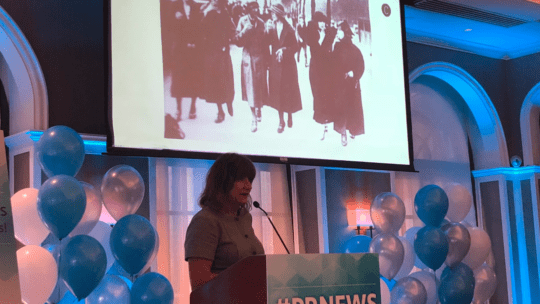
PR professionals are in the business of influencing public opinion, as we all know. But the methods around that influence have changed with the times, says Andy Cunningham, strategic marketing and PR entrepreneur, author of “Get to Aha!” Discover Your Positioning DNA and Dominate Your Competition” and PR News' 2018 Digital Awards Luncheon keynoter.

At the Nov. 8 luncheon, Cunningham delighted attendees with a rundown of the history of PR, and a discussion of establishing a digital footprint using memes and a special kind of content marketing.
PR News caught up with Cunningham after her keynote to hear some more insights:
PR News: You spoke about memes being one of the best ways to create a digital footprint. Any advice for the best way to create one of those memes? Do you think there’s a length that should be followed?
Andy Cunningham: I do think they should be very short, like three or four words maximum. They need to be very pithy and memorable. And they also need to have some deep connection to the narrative that you’re trying to tell. When Trump says “Make America Great Again,” it’s very much connected to the story he’s trying to tell. Or when IBM said “Think,” it was very much connected to the way they were trying to sell computers back in the day.
PR News: You talked a bit about the differences between traditional journalism and the type of content marketing that you think is the best way to influence public opinion. Do you think there is a role for journalists to play in that, especially as a lot of journalists are transitioning into PR roles?
Andy Cunningham: The first thing I want to say is that I have the greatest respect for journalists. It is the greatest defender of democracy that exists on the planet. And it’s because of that defense position that they’re in that they have a very hard time writing copy that is trying to get someone to take an action. Because it feels inauthentic to them. It doesn’t feel like they’re reporting the facts, it feels like they’re manipulating opinion, and I don’t want them manipulating opinion in journalism.
But writing copy to create this digital footprint around a company’s story, it’s all about advocacy of that company. Just writing a good story is not enough. It has to be a story that compels a reader to take an action. And I think journalists have a really hard time with that. It goes against their inner core. So, what happens is…there aren’t a lot of journalism jobs out there right now. So, they take jobs working for PR people, and they end up writing stories that are interesting and good stories, but they don’t do the job that they have to do.
If you really want to create that digital footprint that makes people want to do something related to your company, you have to write in a certain sort of way. It can’t be advertising copy—it’s in between that and journalism.
PR News: That plays into my next question. Since it’s such a niche type of copy—half-way between traditional journalism and content marketing—what, in your experience, is the best way to approach those types of stories to prompt someone to take an action?
Andy Cunningham: I think the first thing is that you have to own up to whatever the situation is, but then you have to steer the reader into a direction. So, for example when I worked for Blackberry, we started off our corporate narrative with essentially this: “Once upon a time, we were a leader in smart phones, and we lost. We lost because we didn’t do this and this and this.” That’s all part of the actual story. You pull the reader in by being authentic and honest. Then, move them over to your point of view by saying, “We lost at this war. So, to continue to survive as a company, we decided to look at the assets that made us great and pull them out and put them over here.”
We came up with this phrase: “We’re no longer about the smart phone, but the smart in the phone.” That became one of our memes. We started inserting that into all of our copy, which is the thing that turned readers toward Blackberry instead of them saying “Oh, that stupid, dead company.” We tried to use that authenticity to gain their credibility and move [the reader] into our other story.
PR News: What’s the biggest PR lesson you learned from working with Steve Jobs?
Andy Cunningham: I don’t know if I actually learned this from Steve, but it’s always been my approach which is why I think it worked well with him and then he helped me go forward with it, which is just to be incredibly honest. One time, when Steve started up his company Next right after he [left] Apple, I wasn’t working for him…He calls me up in the morning and says, “Andy, I’m having this press conference at my house, do you think you could help me?” So, I went over there, I saw there were 50 journalists walking around in the yard…He said, “I’m going to do a press conference about my new company, and these are the people I’m taking with me from Apple to do it, and we’re going to build a new company. And I’m also going to talk about how…they should have never let me go.”
And I looked at him, and I said, “Steve, you can’t do that. That would be a bad thing to do.” And he said, “Ok, I won’t do it.” So the honesty that I showed to him, I just gave him the right advice. Which wasn’t what he wanted to hear, he wanted to hear, “Yes, go for it!” But I told him you can’t do that, and he respected that. And then I got hired by him after that to represent him. I think honesty in public relations is really important. Being honest has always served me very well in the PR space.
Follow Hayley: @that_hayley
Follow Andy: @andycunningham4
